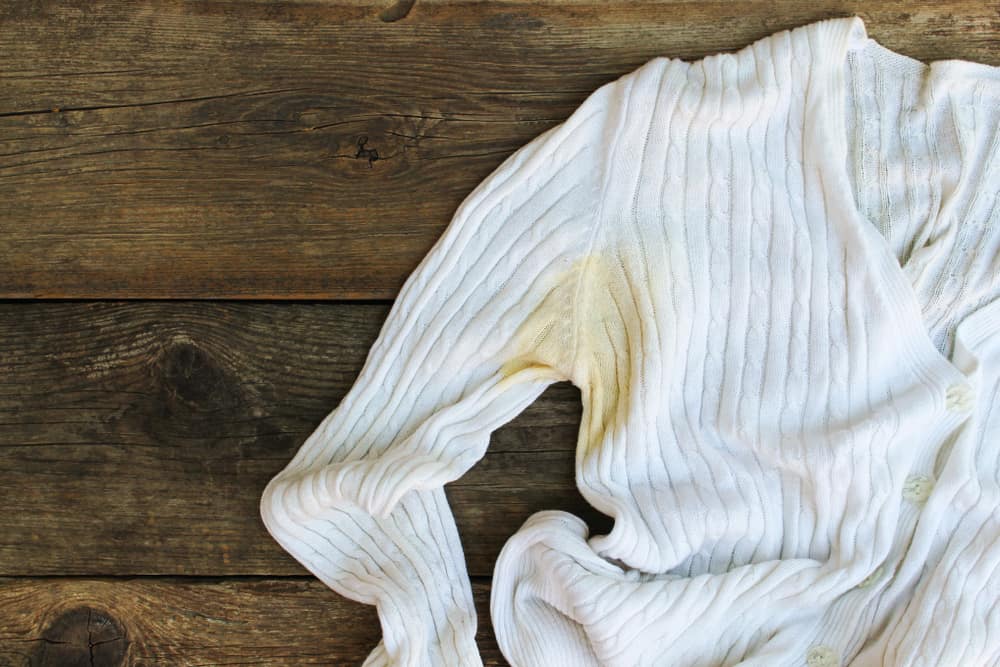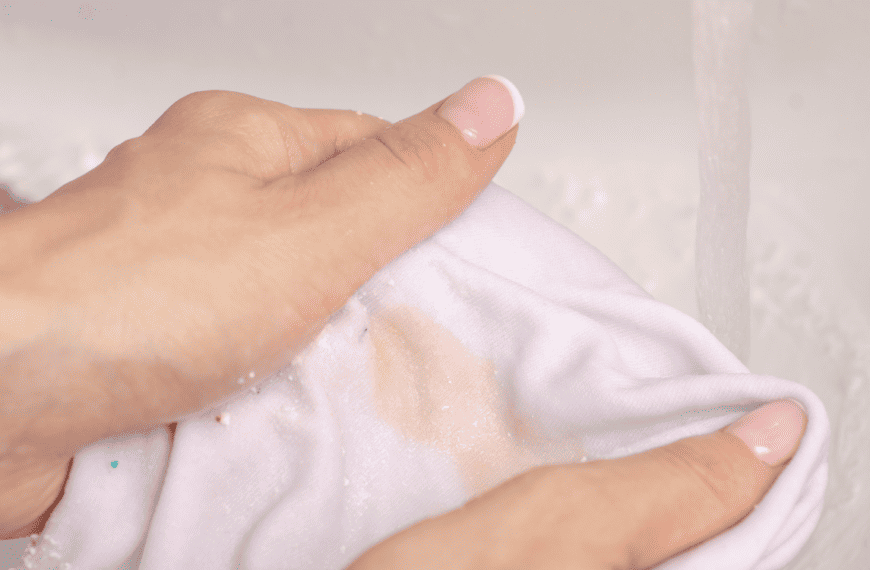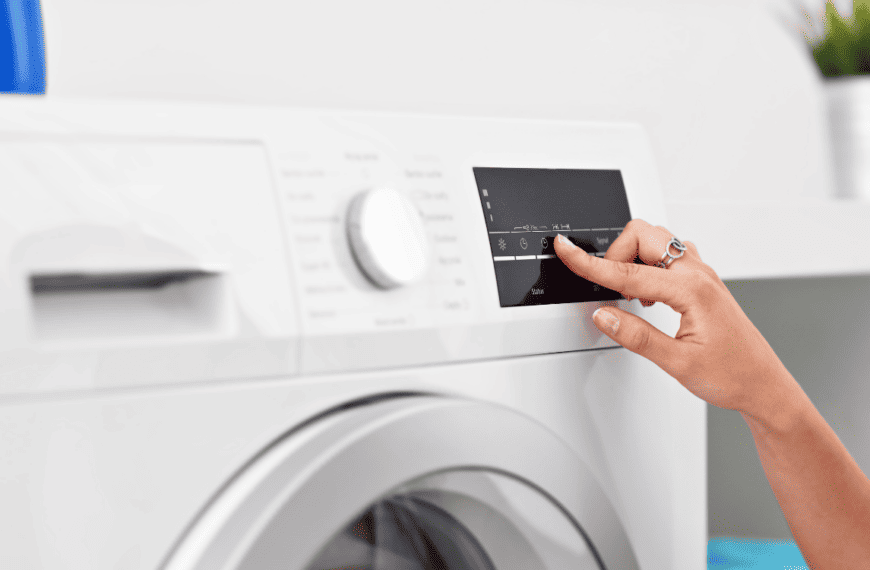Antiperspirant is kind of a double-edged sword. You have to wear it to control sweating and smell fresh, but at the same time, you know it’s leaving a stain on your clothes.
I’ll tell you that removing antiperspirant stains is not the easiest. However, if you want to know how to remove antiperspirant stains and, even more importantly, how to prevent them, I have you covered with these simple methods using just everyday items,
How to Remove Antiperspirant Stains
The easiest and best way to remove antiperspirant stains is to combine hydrogen peroxide, baking soda, water, and dish soap. Combine a ¼ cup of hydrogen peroxide with a ¼ cup of water and a ¼ cup of baking soda. Add about a teaspoon of Dawn dish soap to the mix.
Apply this stain remover to the antiperspirant stains with an old toothbrush while the shirt is inside out. Finally, launder the shirt in cold water and do not place it in the dryer until the antiperspirant stain is gone.
Step by Step Instructions for Removing Antiperspirant Stains
I’ve tried quite a few methods for removing antiperspirant stains. The hardest antiperspirant stains to remove are on white shirts. Here is my go-to method that gives me the best results; however, make sure to only use this method after the stain is set in. For new antiperspirant and deodorant marks on clothing just rinse with cold water and put it through a typical wash cycle with like colors.
Step 1: Create a paste
Mix ¼ cup water, ¼ cup baking soda, ¼ cup white vinegar, and a teaspoon of Dawn dish soap to create a paste.
Step 2: Turn the shirt inside out
Place the shirt inside out so the armpit stains are easily accessible.
Step 3: Place paste on the shirt and scrub
Put your paste on the antiperspirant and deodorant marks and scrub with your fingers or a soft-bristled laundry brush, be mindful of the fabric so you don’t cause any damage.
Step 4: Wash the shirt and repeat
Put the shirt through a normal cold cycle and see if the stain removal method was successful. I would avoid hot water and also ensure that you don’t put the clothing in the dryer until the stain has started to fade.
Alternative Methods For Removing Antiperspirant Stains
I have found that depending on the antiperspirant I’m using, the best stain removal method can vary. Likely this has to do with the chemical makeup of the actual antiperspirant. Here are a few other things I’ve tried that worked:
- White Vinegar: When dealing with a stubborn stain, the white vinegar method works quite well; combine it with a bit of baking soda and use a toothbrush to scrub.
- Lemon Juice: For a fresh antiperspirant stain, lemon juice can work. Use a clean toothbrush to scrub it in and then rinse with cool water.
- Cleaner with Oxygen Bleach: Using a detergent or stain remover with oxygen bleach will encourage a natural bleaching effect without removing color from clothing.
- Bleach: For white clothing, you can try a little liquid bleach or a stain remover with bleach in it, but be careful; if your shirt is more of an off white color.
- Aspirin tablets: If you dissolve two aspirin tablets into one cup of water and then apply it to the sweat and antiperspirant stain, it should help to lighten it.
Mistakes To Avoid When Removing Antiperspirant Stains
With that stained area staring you in the face, it’s hard to avoid hitting your shirt with every stain-fighting method you have. Here are the mistakes to avoid when removing antiperspirant stains:
- Don’t use hot water or even warm water, as it could set the stain in
- Don’t scrub the stain so hard that it damages the shirt itself
- Never put the shirt through the dryer until you have treated the stain and made sure it is removed
- Stay away from boiling water as a stain-removal method
- Don’t forget to read the care label and test an inconspicuous area of the clothing. Do this before using any chemical mixture or commercial stain remover on your clothing
Preventing Antiperspirant Stains on Clothes
In the summer, my sweat glands seem to never take a break. I know I’m not alone on this one, so I’ve had to create some methods to make it easier to remove sweat stains before they get really bad.
- Choose an all-natural antiperspirant or a non-staining formula one
- Keep a small bottle of stain removal solution at the ready in your laundry room; a homemade solution with hydrogen peroxide, vinegar, or baking soda is a great option
- Apply deodorant and antiperspirant and then allow it to completely dry before putting your clothes on.
- Use a garment protector to get the stains off clothes
- Wear multiple layers of clothing so you can cool your body temperature fairly easily and prevent too much sweating.
- Apply your antiperspirant before you put your clothing on, and wipe off with a dry towel or clean cloth if you have excess
- In situations where you know you may sweat more, make sure to choose a color more resistant to antiperspirant stains (medium colors, not black or white)
- Aerosol deodorant can help for even distribution and remove deodorant buildup that increases the likelihood of a stain
Why Do Antiperspirants Stain Clothes?
If you thought your own sweat was causing those yellow stains on your clothing, think again, it’s the antiperspirant designed to stop you from sweating. The active ingredients include aluminum chloride or aluminum salts, which are acidic.
In addition to white marks left on clothes, you will also get difficult-to-remove stains resistant to many stain removal methods.
Antiperspirants vs. Deodorants
Antiperspirant and deodorant stains can be similar. However, a deodorant’s main function is to prevent bacteria and keep odors away. Whereas, antiperspirant blocks sweat glands, prevents sweat from reaching the skin, and offers more robust protection against sweating and odor than deodorant does.
Deodorant’s bacteriostatic property makes deodorant less harsh, leading to lighter stains. Sometimes just a cold water rinse before washing is all that is needed to remove a deodorant stain. Even alternative methods for removing deodorant stains are relatively straightforward.
In general, deodorant stains are just easier to remove. But, the effectiveness of deodorant can vary, depending on each individual’s body chemistry and sweat levels.
Unique Challenges for For Hyperhidrosis Patients
Hyperhidrosis patients often have to apply and reapply antiperspirant, making it difficult to control stains. Soak the affected area with vinegar and allow it to sit about an hour before putting it through the washing machine.
Also, consider putting antiperspirant on the night before and rub it in fully before putting clothes on.
Sweat Stains vs. Antiperspirant Stains
Antiperspirant stains occur because the active ingredient in the antiperspirant mixes with sweat and leaves a residue on the clothing. The stain remains in place over time, making it difficult to remove deodorant stains and antiperspirant stains regardless of the method.
Are Antiperspirant Stains Permanent?
Some antiperspirant stains are permanent. Try to treat the stains within a few hours whenever possible. With white and black shirts, I recommend treating them each time you wash the clothing. Trying to remove deodorant, sweat, and antiperspirant stains only gets harder as the stain sets in.









